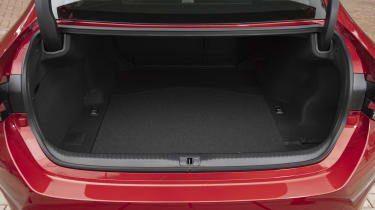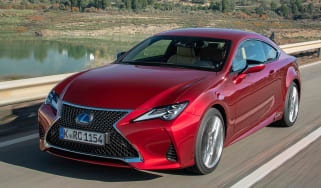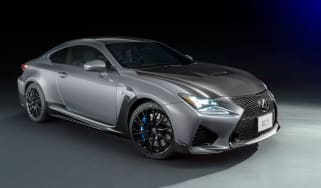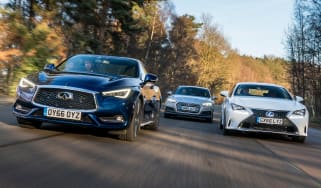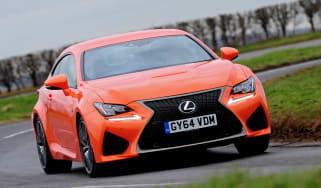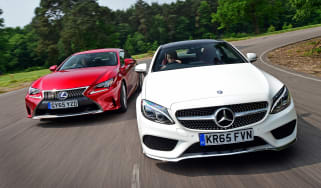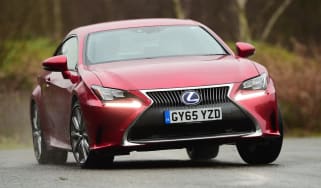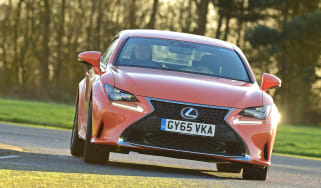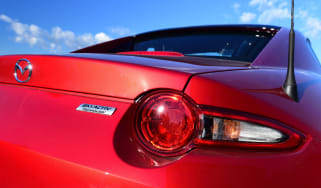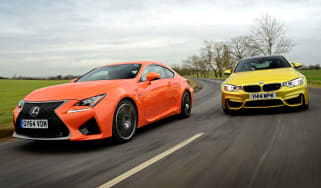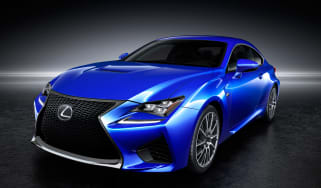Lexus RC (2015-2020) review
Striking Lexus RC is one of the most imposing four-seat coupes around, but also has a high-quality cabin and efficient hybrid

The Lexus RC is the perfect two-door, four-seater coupe for those buyers who don't want to stick to the Germanic norm. Its dramatic styling will sit well with those who like to stand out from the crowd, while it’s typically Lexus in terms of its top-quality cabin design, long kit list and strong refinement.
But the RC doesn’t deliver the polished drive its looks promise, as the BMW 4 Series Coupe is more agile, while the Mercedes C-Class Coupe is more comfortable. Its weight blunts its performance, although the hybrid version has decent running costs. In addition the RC is also less practical than rivals, while the range isn't as broad, either.
The bold looking Lexus RC is a two-door coupe with room for four inside. It was first revealed at the 2013 Tokyo Motor Show, and arrived in UK dealers two years later. The car has since gained a light facelift in 2019 and is still one of the best-looking cars in its class, in our opinion.
The Lexus RC range isn't as broad as some of its rivals, because Lexus doesn't offer diesel engines or manual gearboxes in any of its cars. Instead, the RC features the same single engine as the IS saloon - the RC is essentially the IS in coupe form - so you get a 220bhp 2.5-litre four-cylinder petrol-electric hybrid badged RC 300h, which comes with a E-CVT gearbox only.
Used - available now

2022 Abarth
595
43,817 milesManualPetrol1.4L
Cash £10,299
2023 Volkswagen
Tiguan
12,205 milesAutomaticPetrol1.5L
Cash £24,049
2022 Volkswagen
T-Roc
30,397 milesAutomaticPetrol1.5L
Cash £18,899
2021 SEAT
Ibiza
43,049 milesManualPetrol1.0L
Cash £13,197If this doesn’t sound sporty enough, Lexus also sells the RC F, which is a rival to models such as the Mercedes-AMG C63 and BMW M4. This packs a 471bhp 5.0-litre V8 and eight-speed auto (again, no manual), and manages 0-62mph in 4.5 seconds, which is considerably faster than either of the standard RC models.
The RC 300h comes in standard RC, F Sport and Takumi trims as part of a range refresh that arrived in 2019. All are decently equipped, while the F Sport versions add a more aggressive look, and Takumi models come luxuriously equipped with all the kit you could ever ask for. Prices start from around £38,000, although F Sport and Takumi models break the £40,000 barrier, so will cost £450 in road tax in years two to six of ownership. The RC F starts at just under £60,000, which is on a par with BMW and Mercedes rivals.
Opposition for the standard Lexus RC range comes in the shape of the Audi A5 Coupe, BMW 4 Series Coupe and Mercedes C-Class Coupe, although all three offer a broader range of models to choose from, most of which deliver a more enjoyable driving experience. Elsewhere, the Infiniti Q60 is a direct rival to the RC, although there's no hybrid option on offer. Beyond these coupes, you could consider some four or five-door compact executive saloons, such as the Jaguar XE, Audi A4/A5 Sportback, BMW 3 Series/4 Series Gran Coupe and Mercedes C-Class.
Engines, performance and drive
The RC’s powertrain is found elsewhere in the Lexus range – it comes from the IS saloon – so there are no real surprises. The Japanese brand is well known for doing things a little bit differently to its German rivals, and you can feel that when you get the RC on the road.
It plays the traditional Lexus trump cards of refinement and smoothness pretty well. Wind and road noise are never noticeable, and the engines are whisper quiet most of the time. The only noise that occasionally intrudes is from the suspension, where big bumps around town can send a slight thud through the car, especially on the larger 19-inch wheels found on higher spec versions.
The RC is more firmly set-up than the IS, but apart from some lumpiness around town it’s never uncomfortable. It settles down at speed, too, and is an exceedingly smooth motorway cruiser, especially in models with the adaptive dampers. The Mercedes C-Class Coupe is even more composed, however, and specced correctly it feels less brittle over potholed streets.
Lexus has worked on the RC to give it a sportier, more engaging feel than the IS saloon. It’s not massively successful in this regard, though, especially with the high standard set by rivals. The steering is well-weighted and more direct than you might expect, but quick driving exposes a numbness to the controls. Up the pace and body control suffers too, with the initially sharp turn-in giving way to a heavy, lumpen feel. Given that the RC is around 170kg heftier than the equivalent BMW 4 Series, that’s to be expected.
The hybrid is even heavier due to the battery pack, and body roll is more noticeable than in the turbo petrol. The adaptive dampers go some way to rectifying this in ‘Sport S+’ mode, reducing roll, but it’s still some way away from the composure of the best cars in the class. Grip levels are strong, however.
The RC received steering and suspension tweaks with its 2019 facelift – these have brought sharper turn-in and a more polished ride than before, but the RC is still no match for the BMW 4 Series when it comes to outright fun. The torque-vectoring differential helps it enter and exit corners smoothly, but grip levels aren’t much to shout about. It’s comfortable at a cruise, however, and is one of the most refined performance cars out there.
Engines
There’s just one engine available, a 2.5-litre petrol-hybrid badged RC 300h. Lexus quotes 8.6 seconds to 62mph and top speed is limited to just 118mph. The hybrid's CVT gearbox is particularly frustrating for keen drivers, as it’s too eager to send the revs soaring to an intrusive drone when you press the throttle. There are ‘virtual’ ratios, but there’s often a delay when selecting them via the steering wheel-mounted paddles, plus the transmission still constantly alters the gearing.
The downside is that the RC 300h gets noisy and sluggish if you demand all of its performance at high speed, but the RC is no sports car. The electric motor gives you instant torque and it can run on electric-only mode for a few miles around town.
The RC F’s naturally-aspirated 471bhp V8 makes a great noise and is a real firebreather when revved. It’s certainly more characterful when you’re in the mood than the turbocharged BMW M4. The trade off is a sluggish feeling at low revs, which combines with the weight to make the RC F a car you need to work surprisingly hard to get going.
MPG, CO2 and Running Costs
The RC’s engine options range from the fairly frugal (for a petrol) to the extremely thirsty.
The most efficient on paper is the RC 300h hybrid. It’s capable of 57.6mpg combined cycle economy and CO2 emissions of 113g/km, which will make it attractive to company car buyers. For a naturally-aspirated 2.5-litre four-cylinder petrol engine it’s an impressive figure, but you have to remember that hybrids have a tendency to skew the official numbers. More realistically, you can expect around 40mpg in mixed driving, rising as you cruise around town using electric power and falling at higher speeds when relying on the petrol engine.
That compares well with conventional turbo petrol engines in rivals but then, the RC 300h is less exciting to drive. It’s better measured against diesel alternatives and there things don’t look quite as favourable. For example, the BMW 420d is faster yet more efficient on paper (and in the real world) managing 60.1mpg. The Lexus wins on CO2, however, as the BMW emits 124g/km.
The RC200t shows why it isn’t expected to be the biggest seller in the RC coupe range. It manages just 38.7mpg combined, which looks a bit lacklustre compared to the 53.3mpg of the Mercedes C 200 Coupe and the 42.8mph of the much quicker BMW 428i. In the real-world, you’ll find around 30mpg the norm in sensible mixed driving, which is closer to rivals but still far from impressive. It also emits a fairly substantial 168g/km.
The hot RC F is in a different league when it comes to performance, and also in terms of economy. With a thumping great V8 it achieves 26.2mpg on the combined cycle and emits 252g/km. A BMW M4 gets 32.1mpg and 199g/km, while the outgoing V8-powered Audi RS5 Coupe is similar to the Lexus, at 26.9mpg. In reality you’ll struggle to get the RC F to stay in the low twenties, even if you’re careful.
Insurance
Given the RC’s show-stopping styling, performance and premium image, it makes sense that it’s not that cheap to insure. It starts at group 34 for the RC 300h hybrid which is similar to an Audi A5 2.0 TFSI. The RC 200t is a chunky group 40 in F-Sport trim, however, which is well above any of the established petrol Germans.
The RC F, as you’d expect, won’t be cheap to cover. At group 48, it's comparable with the 503bhp Mercedes C 63 AMG S Coupe.
Depreciation
Lexus’s dependable and solid reputation, combined with its excellent dealer service, means its cars generally fare well for depreciation. Surprisingly, forecasts for the RC aren’t good, however.
All standard RC variants are predicted to retain between 36 and 38 per cent of their value over three years, which is quite a way off the 46-48 per cent of the BMW 4 Series. At least the RC F fares surprisingly well, at around 43 per cent.
To get an accurate valuation on a specific model check out our free car valuation tool...
Interior, design and technology
The Lexus RC’s main appeal for most will be in its arresting looks, which still look fresh in the face of newer competition. We’re becoming used to the Japanese firm’s range of cars getting increasingly bold styling, but the RC is perhaps the prettiest of the lot.
Lexus claims the RC name stands for Radical Coupe, but under the skin the two-door is closely related to the IS compact executive saloon. That model is, in turn, based on the same Toyota New N platform that also underpins the larger GS four-door. All these cars share a traditional front-engined, rear-wheel-drive layout, plus they feature double-wishbone front suspension and a multi-link rear axle.
The dramatic Lexus spindle grille is combined with sharp LED lights and a jutting spoiler to give the front-end real presence. The coupe’s side view is typically muscular and the angular at the rear is certainly distinctive. It’s not to all tastes, but park the Lexus RC next to a BMW 4 Series, and there’s no question which one will draw the most looks. You can also opt for some seriously vivid colours, most notably the optional ‘Solar Flare’ orange paintwork. F Sport versions gain even greater kerb appeal courtesy of the aggressive-looking bodykit and 19-inch alloys.
Inside, the dashboard design has been lifted almost unchanged from the IS. That means mostly excellent fit and finish and premium materials, but not a great deal of flair. Look harder and there is some lovely details, including strips of white ambient lighting on the doors and interior lights that you swipe your finger across to turn on. Another neat touch is the swipe ventilation controls, which are classier than regular knobs but not quite as easy to use.
The driving position is low-slung and hugely adjustable, while the wheel and seats are both leather and electric in all models. Equipment in general is top-notch, with all trims getting sat nav, dual-zone climate control, heated seats (cooled on some models) and cruise control. One thing that is missing, however, is equipment like autonomous emergency braking, which is available on several other rivals.
Sat-nav, stereo and infotainment
All Lexus RCs get a 10.3-inch non-touchscreen display controlled by a touchpad. This can be infuriating to use – especially on the move – as the cursor-style control method isn’t very accurate.
Lexus currently lags behind the best manufacturers when it comes to infotainment. The latest system added to the range at the last facelift represents a step up from the previous model, but it still can’t match those offered by Audi, Mercedes or BMW. Sat-nav is now standard across the range, as are connected services – but Apple CarPlay and Android Auto are not offered.
All models get a reversing camera and Lexus’ Safety System +, which includes adaptive cruise, road sign assist, lane keep assist and automatic high beam headlights, along with ‘Pre Crash Safety’, the brand’s automatic emergency braking system. Top-spec Takumi models get an upgraded 17-speaker Mark Levinson stereo.
Practicality, comfort and boot space
The RC’s ride is firm but comfortable, yet it’s the typically plush and widely adjustable Lexus front seats that really make long journeys a pleasure. F-Sport versions get slightly firmer chairs so if you’re of a larger build or have a bad back it may be worth avoiding those.
In the back is where the main issues lie from a practicality standpoint. Access isn’t too bad for a coupe – the front chairs slide forward electrically on most models even if the mechanism is a little slow. It’s the actual space on offer that’s the problem. It’s fine for children, and the seats split-fold to aid versatility, but adults will have a lot to complain about.
Visibility isn’t much to shout about, even by coupe standards. The view past the A-pillars isn’t a problem, but the car’s long front-end and jutting spoiler can make it difficult to place on the road.
Storage is limited, with a decent glovebox and a lidded cubby between the front seats, but the doorbins are narrow and limited storage in the centre console.
Leg room, head room and passenger space
The Lexus IS isn’t one of the most spacious cars in the compact executive class, and the RC is even poorer. Accessing the rear is tricky, as the powered front seats take a while to move forward, but once you’ve squeezed through you’ll find the sculpted bench gives adequate legroom and just enough headroom. You’ll feel hemmed in, but it's far from uncomfortable.
It’s OK for children, or very short journeys but that’s it. The BMW 4 Series, despite being 60mm shorter and slightly lower, does better in terms of rear seat space, partly thanks to its 80mm longer wheelbase.
Boot space
Boot capacity is not always a priority for a sleek two-door, but many in the class are offering larger load spaces than the RC. Thanks to its batteries encroaching on the boot floor, the RC 300h has a 366-litre boot, ever so slightly smaller than that of the RC F. The RC’s boot opening is small, and the hybrid's battery pack location means there’s no underfloor storage and there are also some awkward load bay intrusions, too.
These figures might sound reasonable, especially given it’s more space than in some family hatchbacks, but the C-Class Coupe offers 400 litres, the 4 Series’ 445 litres, and the Audi A5 a healthy 455 litres.
One mitigating factor is that the RC gets a space-saver spare wheel as standard, whereas on some rivals it’s optional and cuts space. Another is that Lexus has helped you make use of what little space there is, with a 60/40 split-fold rear bench and a ski-hatch.
Reliability and Safety
Traditionally, Lexus has a reputation of making some of the most reliable cars on the road. The brand saw four of its models finish in the top half of the 75 cars included in our 2018 Driver Power customer satisfaction survey, with the CT, IS, NX and RX finishing 30th, 11th, 6th and 5th respectively. The RC itself did not feature, but the performance of its siblings bodes very well.
Lexus beat 25 other manufacturers in our survey to take the overall top spot with a total score of 92.22 per cent. Just nine per cent of owners reported a fault with their cars, versus 18.4 per cent for Audi (19th place) and 28.2 per cent for BMW (21st place).
We expect the RC to prove pretty faultless given that it’s essentially the same as the IS underneath. Don’t be worried by the fancy hybrid technology either – it’s been around in cars like the Prius for years and has proven bulletproof. The hybrid powertrain also gets its own eight-year warranty. Indeed, reliability and ownership experience is an area where the RC starts to claw back some ground on rivals.
Warranty
Lexus models don’t get the same five-year warranty as parent company Toyota’s cars, with buyers having to settle instead for the standard three-year, 60,000-mile cover, although Lexus does offer an extended warranty scheme for cars up to 10 years old at extra cost. The powertrain is covered for much longer, however – five years or 60,000 miles. Buyers also get a 12-year anti-corrosion warranty and a three-year paint warranty.
While it’s unlikely that anything will go wrong with your brand new Lexus, it’s worth noting that some rivals offer more attractive warranties, including a two-year unlimited mileage warranty (plus a third year with a 60,000-mile cap) from Audi, or a three-year, unlimited mileage warranty from Mercedes.
Servicing
Servicing costs are reasonable for a premium model, but Lexus standards of dealer service more than justify any extra outlay. The firm always finishes very highly in dealer satisfaction ratings.
Service intervals for the RC include intermediate services at 10,000, 30,000, 50,000, 70,000 and 90,000 miles, plus full services at 20,000, 40,000, 60,000, 80,000 and 100,000 miles. Each intermediate service is priced at £295; the full services cost from £545 to £675, depending on mileage. Each service also includes a health check of the RC’s hybrid system and adds a one-year, 10,000 mile warranty for the hybrid battery.


